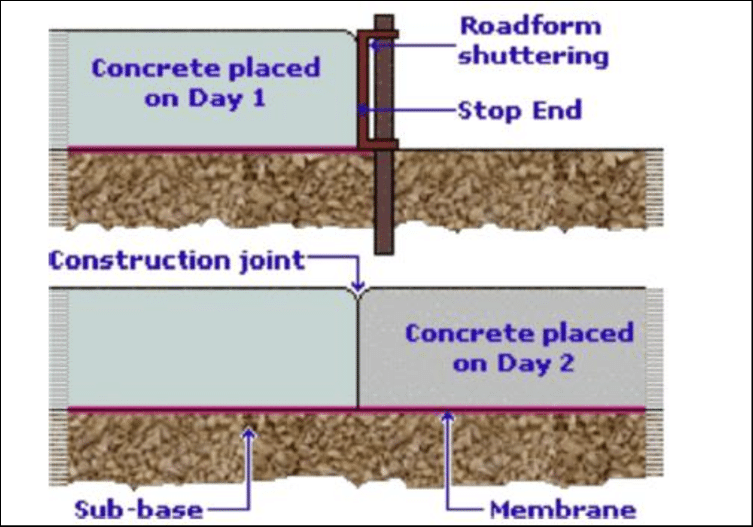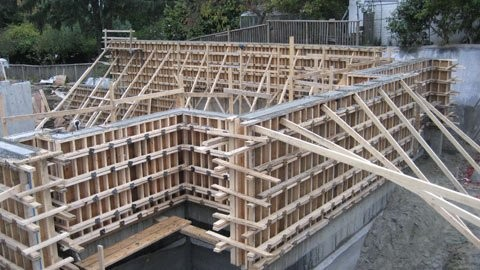Site Preparation for Concrete Placing: In this article, we describe how to prepare the construction site for placing concrete. Site preparation is the first step to take before placing concrete.
Site preparation for concrete placing
Before ordering and receiving concrete from commercial concrete plants, the construction site
has to be prepared carefully.
Site preparations include processing steel reinforcement, setting up formwork, and arranging the handling equipment for concrete.
Different structures have different preparations.
Foundations
Preparation for foundations to receive concrete is complicated due to the large area and excavation involved.
The depth of any foundation excavation should reach sound, undisturbed rock or soil. In order to prevent uneven settlement of the foundation, a big hole that is discovered during excavation must be backfilled with a material that has a similar stiffness to the soil around it.
Rock surfaces must be sound and clean.
If there is any free water, it should be blasted out with air jets or eliminated using other techniques. In some circumstances, it might be essential to construct a sump (outside the form area) for the water to drain into so that it can be removed using a pump.
When concrete is poured during the winter, foundations should be clear of frost and ice.
The soil should be wet but not muddy during the dry seasons.
To make sure the path is not blocked, steel shafts for caissons and shells for cast-in-place piles should be examined.
Construction joints
For a structural member with large areas or volumes or big heights, it is impossible to cast the whole member at one time.
Concrete casting eventually comes to an end due to supply, building procedure, and time constraints, leaving a construction joint to divide the presently cast concrete from the later resumed casting.
A construction joint may be horizontal or vertical, depending on the type of structural member and construction process.

The size of the structural member, the amount of concrete that can be supplied over the course of the project, the coefficient of thermal expansion, the construction schedule, the distribution of moments and shear forces within the structural member, and the concrete’s shrinkage characteristics must all be taken into consideration when determining where construction joints should be placed.
The joint should be made in a plane normal to the main reinforcing bars and in a region with minimum shear force.
To prevent the structure’s strength from being compromised, construction joints must be created and placed properly.
The concrete surface where a joint is to be created has to be cleaned and laitance removed.
All construction joints must be wetted and any standing water must be drained before new concrete is poured.
Reinforcing steel is normally continuous across a construction joint to keep the concrete structure unified as whole.
Formworks
Before casting concrete, a formwork has to be built. The formwork is a temporary mold into which concrete is poured.
Until the concrete hardens and can take the load on its own, the formwork supports some construction load as well as the dead load of fresh concrete.
Steel plates or wood boards can be used to construct the formwork.

Clean, tight, and sturdy formwork is necessary to support the wet concrete and withstand the pressure that the liquid concrete creates.
The formwork lining should be coated with appropriate oil or parting compound to aid in demolding.
To prevent wood from absorbing water from the concrete, wood forms should be wetted with water before concrete pouring.
Permanent formwork is a part of a concrete structure that can be used to hold the fresh
concrete, mold it to the required dimensions and remain in place for the life of the structure.
Steel tubing serves as a permanent formwork in the steel tube-reinforced concrete.
Permanent formwork can decrease the need for professional formworkers on a building site, speed up construction, enhance curing, lessen shrinkage, save construction costs, and increase safety by removing potential risks. Additionally, it lessens the production of construction waste during building.
Reinforcing steel
After the formwork is built up, a reinforcing steel cage has to be put into the formwork before concrete casting.
Steel stirrups placed correctly should hold the primary reinforcing steel bars.
The reinforcing steel should be free of dirt, paint, oil, grease or other foreign substances.
Wire brushing should be used to get rid of the rust. All reinforcing steel needs to be held precisely in place while being placed and compacted.
Chairs, ties, or hangers should be used to maintain distances from the forms.
The steel cage used for reinforcement must be strong enough to support the weight of the construction.
Embedded items
Various fixtures and items, such as manholes, anchor bolts, pipelines, devices for health monitoring, and tubes for retaining prestress tendons, are embedded in many concrete constructions. The majority of them need to be secured in position before concrete is poured by being fastened to the formwork or the reinforcing steel. Only when the load-carrying capacity is unaffected may adjustments be made to the steel placement to make room for these objects.
